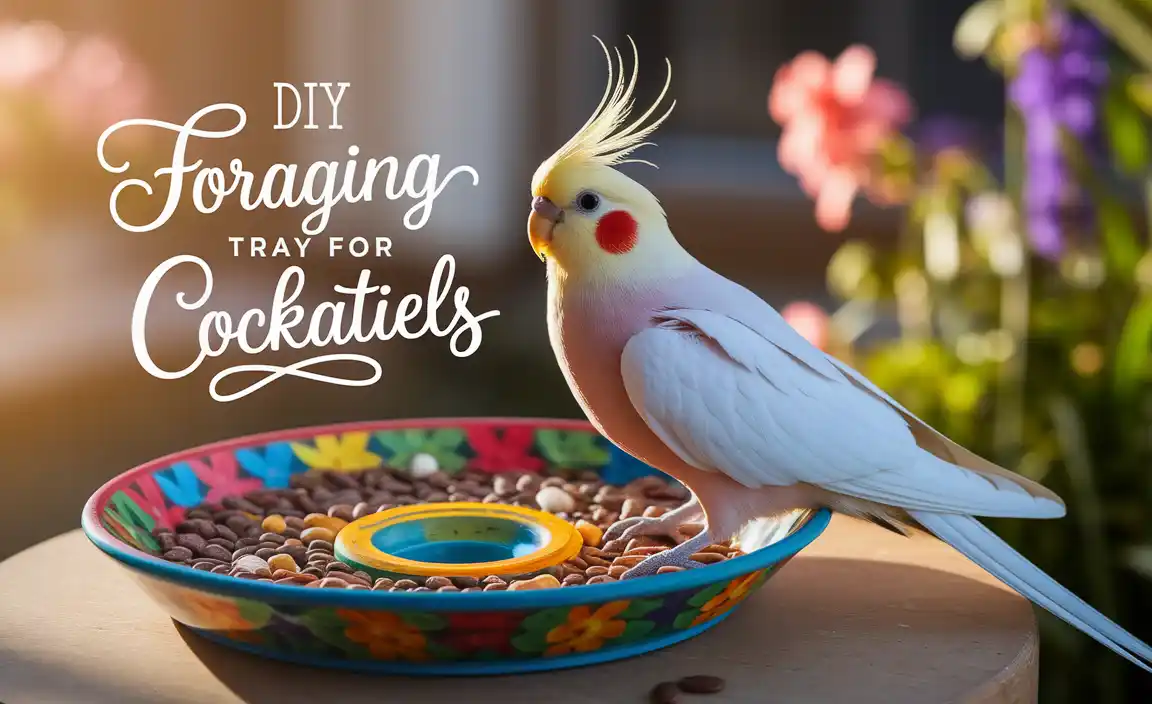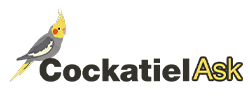Imagine your cockatiel gleefully playing while finding its favorite treats. Have you ever tried making a foraging tray to entertain it? A simple, homemade tray can bring hours of fun and exercise. Cockatiels love exploring, and creating a special tray lets them do just that.
Let’s picture this: your cockatiel, Charlie, is looking slightly bored. What if you could turn that boredom into excitement? By learning how to make a foraging tray, you can transform its day into a treasure hunt. Did you know cockatiels in the wild love foraging for food? It’s how they stay sharp and healthy.
You might wonder, “What do I need?” Don’t worry, creating a foraging tray is easy. All you need are some common household items. This project involves both creativity and fun, making it a perfect rainy day activity. Are you ready to surprise your feathery friend with a new playtime adventure?

Creating The Perfect Foraging Tray For Cockatiels
Imagine your pet cockatiel on a treasure hunt each day. Creating a foraging tray keeps them engaged and happy. Start with a shallow tray or box. Add shredded paper or hay, making it look like a fun mess. Sprinkle seeds, nuts, and bits of fresh fruit within the layers. Your bird will love searching for these tasty treats. Plus, it’s an easy way to enrich their life! Ready to surprise your feathered friend?
Understanding the Importance of Foraging for Cockatiels
Benefits of foraging for mental stimulation. How foraging mimics natural behaviors.
Cockatiels need foraging for a happy mind. Foraging helps them think better. It’s like solving a puzzle. They feel less bored. Birds in the wild search for food. This keeps them active and alert. We can mimic this at home.
- Mental Stimulation: Finding food in new places keeps their brain busy.
- Mimicking Nature: Searching for food mimics wild bird behavior, keeping them happy.
Foraging makes them healthy and smart!
Why do cockatiels need a foraging tray?
A foraging tray can mimic a cockatiel’s natural environment. It provides mental fun and lets them explore safely indoors. By exploring, they stay curious and sharp.
Materials Needed for a DIY Foraging Tray
Safe materials for cockatiels. Where to source materials inexpensively.
Creating a cozy foraging tray for your cockatiel is easy and fun! You’ll need safe materials that won’t harm your feathery friend. **Plain paper**, untreated wooden blocks, and natural rope are excellent choices. Find these at craft stores or online, where bargains await. If you’re on a tight budget, check out local yard sales for hidden treasures! Remember, your cockatiel’s beak is its pride, so avoid painted or metal items. Happy foraging, and may the treats be ever in your favor!
| Material | Source | Cost |
|---|---|---|
| Plain Paper | Craft Store | Low |
| Wooden Blocks | Online | Moderate |
| Natural Rope | Local Yard Sale | Low |
If your cockatiel could speak, it might say, “Why buy toys when you can make them?” Keep their space interesting, use creativity, and watch them explore their new playground!
Step-by-Step Guide to Building a Foraging Tray
Constructing the base and structure. Creating compartments for foraging materials.
Building a foraging tray for your cockatiel is fun. First, find a small, flat box. This is your base. Then, add walls from cardboard or plastic. Next, create sections with dividers. Use small pieces of cardboard to make these. Fill these sections with seeds, paper, and safe toys. This makes it like a treasure hunt for your bird. Use non-toxic materials.
Why do cockatiels need a foraging tray?
Cockatiels need foraging trays because they love to explore and search for food. This keeps them happy and active. It helps them stay healthy and avoids boredom. Foraging trays make their life more exciting and natural.
How can I make the foraging materials safe?
Ensure all materials are bird-safe. Avoid sharp items or things they can swallow. Use food-grade paper and natural toys. Size should match bird’s beak to prevent choking. Always supervise at first, ensuring safety and fun go hand in hand.
Choosing the Right Foraging Items
Safe and engaging items for cockatiels. Common household items that can be repurposed.
Cockatiels are curious creatures, and choosing the right foraging items can turn snack time into a fun adventure. Use safe items like untreated wood and paper. A cardboard tube can be a treasure chest for treats! Try using common household things like empty paper towel rolls and bottle caps. And don’t forget about popping a seed mix into a tissue box. Just make sure everything is free of sharp edges and harmful chemicals.
| Item | Usage |
|---|---|
| Untreated Wood | Chewable toys |
| Cardboard Tubes | Hide treats inside |
| Paper Towel Rolls | Stuff with papers or seeds |
| Bottle Caps | Scatter for play |
| Tissue Box | Seed dispenser |
Turning everyday objects into toys isn’t magic, but it sure feels like it when you see their excited little faces. Always keep an eye on them; their tiny beaks are like mini scissors!
Incorporating Variety and Challenges
Rotating items to maintain interest. Adding complexity to encourage problemsolving.
Mix different items to keep your cockatiel excited. Switch toys and treats every few days. This keeps their mind active and curious. Add some twists to their foraging tray to make it more interesting. Use hidden treats in toys. Try placing puzzles they can solve. These changes make your bird think. It’s like a fun game!
Why add challenges to a foraging tray?
Adding challenges helps improve your bird’s thinking skills. It makes them use their brain more. This is good for their overall well-being! They stay sharp and learn how to solve problems.
Maintaining and Cleaning the Foraging Tray
Regular cleaning guidelines for hygiene. Inspecting for wear and potential hazards.
To keep your cockatiel’s foraging tray clean, wash it every few days with mild soap and warm water. This prevents germs from growing. Always of inspect the tray for wear and potential hazards. This includes sharp edges or broken pieces. Regular checks ensure your pet stays safe. When cleaning, rinse thoroughly to ensure no soap is left behind. A clean tray is a happy tray!
Why is it important to clean the tray often?
Cleaning prevents the buildup of bacteria and germs. This helps keep your bird healthy. Birds can get sick if the tray isn’t clean. Cleaning also stops bad smells from forming.
Adjusting the Tray Design for Different Needs
Adapting foraging trays for multiple birds. Customizing trays for varying skill levels.
When making foraging trays for cockatiels, customization offers a world of possibilities! To adapt for multiple birds, opt for a larger tray, ensuring each bird has enough space to explore. Remember, nobody likes bumper-to-bumper traffic, especially not our feathered pals!
For birds at different skill levels, mix and match challenges. Beginners might enjoy simple hiding spots, while seasoned foragers might prefer more intricate mazes. Think of it like a birdie escape room: fun for everyone, tail feathers optional.
| Skill Level | Tray Design Suggestion |
|---|---|
| Beginner | Simple open spaces with minimal obstacles |
| Intermediate | Several small, hidden compartments |
| Advanced | Complex mazes and interactive elements |
Remember, creating a successful foraging tray involves observing your birds and understanding their preferences. As famed author Virginia Woolf once quipped, “One cannot think well, love well, sleep well if one has not eaten well.” Make sure your birds are well-fed and entertained!
Conclusion
Creating a foraging tray for cockatiels is fun and easy. Gather safe materials like untreated wood and paper. Add healthy treats and toys to engage their curiosity. Start simple, then gradually increase challenges. Your bird will love discovering surprises. Explore more about cockatiel care to keep your feathered friend happy and healthy!
FAQs
What Materials Are Safe And Suitable For Creating A Foraging Tray For Cockatiels?
To make a safe foraging tray for cockatiels, use natural materials like untreated wood or paper. You can also use bird-safe plastic or stainless steel. Avoid materials with sharp edges. Make sure everything is non-toxic and free from small parts they could swallow. Your feathered friend will enjoy exploring and playing safely!
How Can I Design A Foraging Tray That Encourages Natural Foraging Behaviors In Cockatiels?
To make a foraging tray for cockatiels, start with a shallow tray or box. Add paper strips, leaves, or hay to hide small treats. Use healthy seeds or tiny pieces of fruits and nuts as treats. Place the treats under the paper or leaves so the birds can dig and find them. This way, your cockatiels will have fun searching for their food just like they do in the wild!
What Types Of Treats Or Foods Are Best To Include In A Cockatiel’S Foraging Tray?
A cockatiel’s foraging tray can have yummy seeds, fresh fruits, and chopped veggies. Try sunflower seeds, apple bits, and tiny carrot pieces. You can also add small nuts and cooked pasta. Make sure everything is cut into small pieces to keep your bird safe and happy!
How Do You Introduce A Foraging Tray To A Cockatiel That Has Never Used One Before?
To introduce a foraging tray to your cockatiel, start by showing it to them slowly. Place some treats and favorite toys on top of the tray. Let your cockatiel watch you put the treats there so they get curious. Once they start exploring, praise them with a happy voice. Be patient and let them take their time.
What Are Some Creative Ways To Keep A Cockatiel Engaged With Their Foraging Tray Over Time?
We can keep your cockatiel excited by changing the items in its foraging tray often. You might hide small treats or toys under shredded paper or cardboard. Sometimes, use different textures or colorful objects to make it more fun. We can also try using puzzle toys to make them think and search for their treats. Remember to change things up so your cockatiel stays interested!
